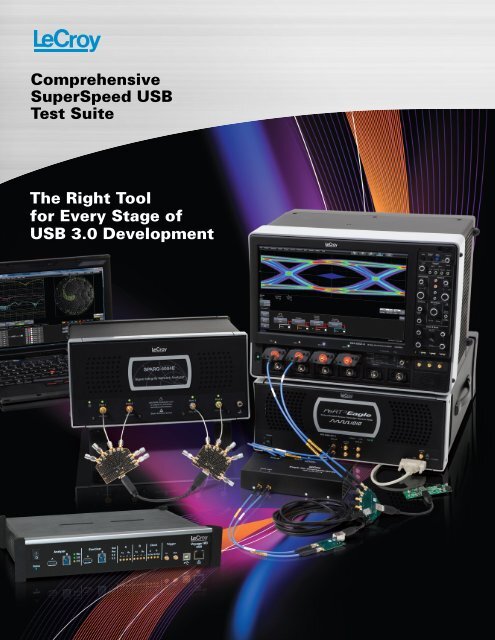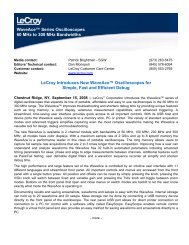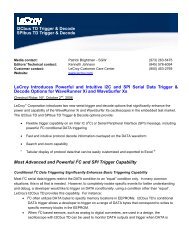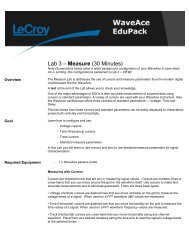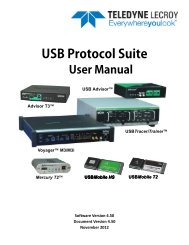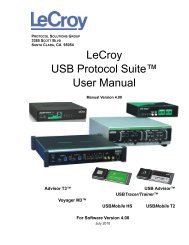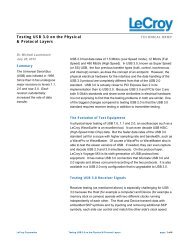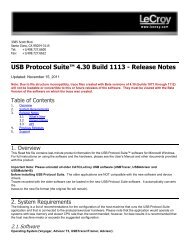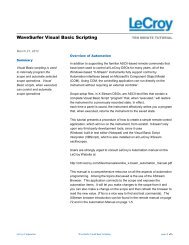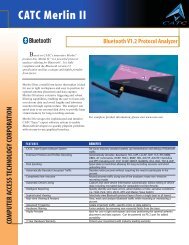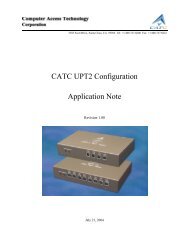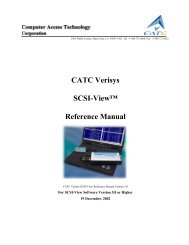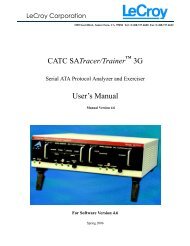LeCroy Comprehensive SuperSpeed USB Test ... - Teledyne LeCroy
LeCroy Comprehensive SuperSpeed USB Test ... - Teledyne LeCroy
LeCroy Comprehensive SuperSpeed USB Test ... - Teledyne LeCroy
You also want an ePaper? Increase the reach of your titles
YUMPU automatically turns print PDFs into web optimized ePapers that Google loves.
<strong>Comprehensive</strong><br />
<strong>SuperSpeed</strong> <strong>USB</strong><br />
<strong>Test</strong> Suite<br />
The Right Tool<br />
for Every Stage of<br />
<strong>USB</strong> 3.0 Development
2<br />
<strong>Comprehensive</strong> Verification, Debug and Compliance<br />
Successful development of new <strong>USB</strong> 3.0 products requires a coordinated test program, running from transmitter<br />
testing (to verify eye diagrams, jitter, and other performance measurements), to receiver testing (to ensure<br />
reliable data transfer), to S-parameter and TDR testing (to ensure reliable channels, PCB designs, connectors<br />
and cables), and finally to protocol testing (to ensure functionality and compliance to <strong>USB</strong> 3.0 requirements).<br />
Single Vendor Solution<br />
<strong>LeCroy</strong> is the only company that offers<br />
a complete line of <strong>USB</strong> 3.0 test<br />
solutions covering transmitter test<br />
to protocol test, and every step in<br />
between for comprehensive<br />
verification, debug and compliance.<br />
<strong>SuperSpeed</strong> <strong>USB</strong> test needs are<br />
supplied with a single point of<br />
procurement and support. Further,<br />
<strong>LeCroy</strong> provides uniquely integrated<br />
test solutions that combine test<br />
capabilities at multiple levels and<br />
merge the results for more accurate<br />
and meaningful information.<br />
<strong>LeCroy</strong>’s experience and leader ship in<br />
providing high-speed serial data test<br />
tools make <strong>LeCroy</strong> the natural choice<br />
as a test partner for <strong>SuperSpeed</strong><br />
<strong>USB</strong> development.<br />
<strong>LeCroy</strong>’s test tools cover the full<br />
range of test needs: industry-leading<br />
oscilloscopes for transmitter testing,<br />
unique products such as the<br />
Protocol-enabled Receiver and<br />
Transmitter Tolerance <strong>Test</strong>er<br />
(PeRT3), specialized solutions for<br />
S-parameter and TDR testing on<br />
sampling oscilloscopes, and a full line<br />
of serial data protocol analyzers. Our<br />
test tools are not only superb in their<br />
own test areas, but because they are<br />
well integrated with each other, they<br />
help engineers easily move test<br />
designs and results from one <strong>LeCroy</strong><br />
system to another providing quicker<br />
and deeper insight for confidence in<br />
measurement results.<br />
The Right Support for<br />
Every Stage of Development<br />
The PeRT3 <strong>Test</strong> System, which<br />
integrates receiver test with<br />
protocol-awareness, provides the<br />
ability to automate testing through<br />
active control of the device under<br />
test, and to integrate diverse test<br />
results from multiple levels. It is also<br />
able to easily manage through<br />
protocol issues such as SKP symbols<br />
which can interrupt testing on<br />
competitive products.
QualiPHY, <strong>LeCroy</strong>’s automated test<br />
engine, is the only solution that fully<br />
integrates and automates transmitter<br />
and receiver testing. QPHY-<strong>USB</strong>3-Tx-Rx<br />
permits the scope to communicate<br />
directly with the PeRT3 automating<br />
both instruments and creating<br />
compliance reports that include both<br />
transmitter and receiver results.<br />
<strong>LeCroy</strong> provides the right tools for you<br />
every step of the way. Our coordinated<br />
solutions guide you through the most<br />
difficult engineering and development<br />
tasks and help ensure product goals of<br />
performance, quality, reliability and<br />
time-to-market are all met.<br />
About <strong>SuperSpeed</strong> <strong>USB</strong><br />
Developed and promoted through the<br />
<strong>USB</strong> Implementers Forum (<strong>USB</strong>-IF),<br />
<strong>USB</strong> has been long established as<br />
the interconnect system of choice<br />
for peripheral systems.<br />
<strong>SuperSpeed</strong> <strong>USB</strong> is backwards<br />
compatible with <strong>USB</strong> 2.0, ensuring<br />
a smooth adoption path for all<br />
users. However, for developers the<br />
challenges of <strong>USB</strong> 3.0 are daunting.<br />
High-speed gigabit serial data links<br />
require new design approaches, high<br />
quality manufacturing processes, and<br />
comprehensive testing and debug<br />
procedures to achieve reliable data<br />
transfer and interoperability.<br />
Key <strong>USB</strong> 3.0 <strong>Test</strong> Specifications <strong>LeCroy</strong> <strong>USB</strong> 3.0 <strong>Test</strong> Solution<br />
• Data rates of 5 Gb/s<br />
• Continuous Time Linear Equalization<br />
• Eye Diagram and Jitter test performed at<br />
the far end of a compliance test channel<br />
• Loopback Mode Initiation<br />
• Jitter Tolerance Requirement<br />
• Transmitter, Receiver and Cable TDR and<br />
S-parameter <strong>Test</strong>s<br />
• Full power management (idle, sleep, suspend<br />
states as well as Link-, Device- and Function-level<br />
power management)<br />
• Host-device communications pipe<br />
• New Streams bulk transfer type<br />
• Adaptation of proven PCI Express ® 2.0<br />
technologies—5 Gb/s, 8b/10b encoding, linear<br />
feedback shift register (LFSR), data scrambling,<br />
spread spectrum clocking (SSC)<br />
• Receivers must implement LFSR, dynamic<br />
equalization and training sequences to ensure<br />
fast lock<br />
• Bus power increased to 150 mA per unit load<br />
(+50%), and configured devices can draw up to<br />
6 unit loads (900 mA, +80%)<br />
The <strong>SuperSpeed</strong> <strong>USB</strong> Compliance<br />
<strong>Test</strong> Specification requires the use<br />
of reference channels and continuous<br />
time linear equalization (CTLE) for<br />
compliance measurements. The<br />
SDA 813Zi-A with the Eye Doctor II<br />
analysis package has the ability to<br />
emulate the reference channel and<br />
the CTLE as specified for both<br />
compliance measurements and to<br />
troubleshoot the root cause of<br />
compliance failure.<br />
Another of the new <strong>SuperSpeed</strong><br />
<strong>USB</strong> capabilities is Optimized Power<br />
Management which requires all<br />
devices to actively manage<br />
SDA 813Zi Oscilloscope with<br />
Eye Doctor II Software<br />
Eagle PeRT 3 System<br />
SPARQ-4004E<br />
Voyager M3i <strong>USB</strong> 3.0 Pro<br />
Analyzer Exerciser System<br />
power (sleep states, etc.). The<br />
development and test of this feature<br />
requires equipment that is able to<br />
simultaneously monitor both physical<br />
and protocol levels.<br />
The Power Tracker option for the<br />
Voyager <strong>USB</strong> 3.0 Protocol Analyzer<br />
simultaneously captures both protocol<br />
traffic and power consumption,<br />
allowing engineers to quickly isolate<br />
and identify problems in ensuring<br />
compliance to the new power<br />
management requirements.<br />
3
4<br />
The Perfect Oscilloscope for<br />
<strong>SuperSpeed</strong> <strong>USB</strong> <strong>Test</strong>ing<br />
The <strong>LeCroy</strong> SDA 8 Zi-A Series of<br />
oscilloscopes with the Eye Doctor II<br />
analysis package are the perfect<br />
instruments for performing<br />
<strong>SuperSpeed</strong> <strong>USB</strong> compliance<br />
measurements and more importantly<br />
for debugging compliance failures<br />
allowing the engineers to quickly find<br />
the root cause of serial data problems.<br />
Eye Doctor II provides the channel<br />
emulation, de-embedding and<br />
equalization tools that engineers<br />
need for next generation serial data<br />
standards. These features are required<br />
for <strong>SuperSpeed</strong> <strong>USB</strong> testing since<br />
a compliance test channel must<br />
be emulated and the signal must be<br />
equalized using a Continuous Time<br />
Linear Equalizer prior to eye diagram<br />
and jitter analysis. SDA II allows the<br />
user to quickly create eye diagrams<br />
utilizing the full record length of the<br />
oscilloscope, and perform jitter<br />
analysis accurately, even when there<br />
is a very long non-repeating pattern.<br />
Additionally, SDA II has two different<br />
jitter breakdown methodologies and<br />
the deepest jitter analysis toolbox for<br />
correctly identifying sources of jitter.<br />
Also, SDA II has unique eye diagram<br />
analysis tools, such as IsoBER, for<br />
providing even deeper insight into<br />
eye diagrams.<br />
The SDA 8 Zi-A Series of oscilloscopes<br />
provides the best asset investment<br />
protection available. With the widest<br />
bandwidth upgrade range, an engineer<br />
who is working on 2nd generation<br />
technologies today can confidently<br />
know that WaveMaster 8 Zi-A will<br />
support 3rd or 4th generation<br />
technology needs several years from<br />
now. Also, the SDA 8 Zi-A Series of<br />
oscilloscopes has the lowest jitter<br />
noise floor for <strong>SuperSpeed</strong> <strong>USB</strong><br />
measurements.<br />
Transmitter Compliance<br />
<strong>Test</strong>ing<br />
When you add QPHY-<strong>USB</strong>3-Tx-Rx<br />
to the SDA 8 Zi-A oscilloscope, you<br />
have the ideal <strong>SuperSpeed</strong> <strong>USB</strong><br />
Compliance <strong>Test</strong> Instrument.<br />
Tx Rx<br />
Fixture<br />
Product<br />
Under <strong>Test</strong><br />
QPHY-<strong>USB</strong>3-Tx-Rx is an automated<br />
test package for <strong>SuperSpeed</strong> <strong>USB</strong><br />
compliance testing. It provides<br />
connection diagrams to ensure<br />
the proper setup for the required<br />
measurements, automates the<br />
oscilloscope for performing these<br />
measurements, and provides a<br />
comprehensive report of results<br />
including screenshots.<br />
QPHY-<strong>USB</strong>3-Tx-Rx uses all of the<br />
powerful oscilloscope features to<br />
perform the compliance tests as<br />
described by the <strong>USB</strong> 3.0 Electrical<br />
<strong>Test</strong> Specification.<br />
Using the PeRT 3 Phoenix<br />
for Transmitter <strong>Test</strong>ing<br />
Transmitter link equalization<br />
response test requires the test<br />
instrument to handshake with the<br />
DUT in the protocol layer to test<br />
the DUT’s response to different<br />
equalization setting requests.<br />
<strong>LeCroy</strong> PeRT3 Phoenix is specifically<br />
designed to address this requirement<br />
for PCI Express Gen3.
PeRT 3 <strong>Test</strong> System<br />
The PeRT 3 (Protocol-enabled Receiver<br />
and Transmitter Tolerance <strong>Test</strong>er) fills<br />
the space between physical layer<br />
test and protocol test, providing a<br />
new and more intelligent capability for<br />
performance testing of receivers and<br />
transmitters. Designed to meet the<br />
test needs of engineers working with<br />
serial data transceivers and other highspeed<br />
serial data communication<br />
systems, the <strong>LeCroy</strong> PeRT3 <strong>Test</strong><br />
System is not just a new instrument,<br />
it is an entirely new instrument class.<br />
Complete Characterization in<br />
Development or Automated<br />
<strong>Test</strong> Environments<br />
The PeRT3 is designed to test<br />
receivers under conditions of stress<br />
by starting with a clean signal and<br />
gradually introducing measured levels<br />
of a variety of different stress types<br />
into the signal, and simultaneously<br />
monitoring the bit error rate (BER) to<br />
explore the full performance envelope<br />
of the receiver system.<br />
Because the system is able to<br />
interpret and generate protocol traffic,<br />
the PeRT 3 is uniquely able to manage<br />
fully-automated testing of <strong>USB</strong> 3.0<br />
products. For example, the PeRT3 can initialize the remote device and<br />
command the device to enter or exit<br />
loop-back mode while testing is in<br />
progress. In addition, the PeRT3 is<br />
capable of intelligently managing<br />
automated testing through events<br />
which disrupt other test systems,<br />
such as the addition or deletion of<br />
SKP symbols by devices in the data<br />
traffic pattern.<br />
The PeRT3 allows you to extend<br />
testing into protocol areas, such as<br />
measuring CRC errors, frame errors<br />
and other protocol-specific criteria<br />
Tx<br />
Rx<br />
Compliance<br />
<strong>Test</strong><br />
Channel<br />
(<strong>USB</strong>-IF supplied)<br />
Rx<br />
Tx<br />
Fixture<br />
while actively adding measured<br />
amounts of stress into the signal,<br />
such as increased jitter and noise.<br />
With a single integrated system,<br />
the PeRT3 replaces up to 6–8 other<br />
instruments and greatly simplifies<br />
experimental setup, increases the<br />
ease of designing and conducting<br />
fully automated testing, and provides<br />
specific test suites to ensure receiver<br />
compliance to <strong>USB</strong> 3.0 specifications.<br />
Calibrating the Jitter<br />
Output of the PeRT3 Receiver test specifications<br />
require calibration of the jitter<br />
output sources for the test<br />
instrument. When using the<br />
PeRT3 in conjunction with<br />
SDA 8 Zi-A oscilloscope, this<br />
calibration is done automatically<br />
by the QPHY-<strong>USB</strong>3-Tx-Rx<br />
application.<br />
Product<br />
Under <strong>Test</strong><br />
5
6<br />
Key Features<br />
• QPHY-<strong>USB</strong>3-Tx-Rx<br />
supports all transmitter<br />
compliance tests as<br />
described by the<br />
<strong>SuperSpeed</strong> <strong>USB</strong><br />
Electrical Compliance <strong>Test</strong><br />
Specification (Rev 0.7),<br />
and selected tests in<br />
accordance with the<br />
Universal Serial Bus 3.0<br />
Specification<br />
• Automated physical layer<br />
transmitter and receiver<br />
compliance testing<br />
including receiver jitter<br />
source calibration<br />
• SIGTEST electrical test<br />
software is fully<br />
integrated into the<br />
oscilloscope software<br />
• QPHY-<strong>USB</strong>3-Tx-Rx<br />
provides full reporting<br />
capability including<br />
Pass Fail indications<br />
and screenshots from<br />
pertinent tests<br />
• Eye Doctor II Advanced<br />
Signal Integrity Tools<br />
enable channel emulation<br />
and equalization which<br />
aids in debugging<br />
<strong>SuperSpeed</strong> <strong>USB</strong><br />
compliance failures<br />
• SDA II allows fast eye<br />
diagram creation and<br />
jitter analysis on long<br />
memory acquisitions<br />
Fully automated <strong>SuperSpeed</strong> <strong>USB</strong> Transmitter and Receiver <strong>Test</strong>ing.<br />
When combining the power of the SDA 8 Zi-A Oscilloscope with the<br />
unique features of the PeRT3 the perfect test setup for <strong>SuperSpeed</strong> <strong>USB</strong><br />
compliance test is created.<br />
When using the SDA 8 Zi-A<br />
oscilloscope for transmitter only<br />
testing, the user is still required to<br />
stimulate the product under test<br />
to output the required test patterns<br />
for each of the transmitter tests.<br />
Likewise, when using the PeRT3 for receiver only testing, the<br />
specification requires the user to<br />
calibrate the jitter output sources<br />
prior to performing the receiver<br />
test. By making the appropriate<br />
connections to the <strong>USB</strong>-IF test fixture,<br />
the SDA 8 Zi-A oscilloscope and PeRT3 can uniquely interoperate to achieve<br />
the fastest and most accurate<br />
<strong>SuperSpeed</strong> <strong>USB</strong> product qualification.<br />
All of these test results are then<br />
combined into a single test report.<br />
PeRT3 Value in<br />
Transmitter <strong>Test</strong>ing<br />
Although, the PeRT3 is primarily<br />
used for receiver testing, it can also<br />
be used to communicate with the<br />
product under test on the protocol<br />
layer (Ping.LFPS commands) to<br />
stimulate it to output the required<br />
compliance patterns for transmitter<br />
tests. The transmitter of the PeRT3 For more information on the <strong>USB</strong> 3.0<br />
test capabilities of the SDA 813Zi-A and<br />
QPHY-<strong>USB</strong>3-Tx-Rx, see the document<br />
“<strong>USB</strong> 3.0 <strong>Test</strong> Solutions QPHY-<strong>USB</strong>3-Tx-Rx”<br />
available from www.lecroy.com.
can be connected to the receiver<br />
of the product under test, while<br />
the transmitter of the product<br />
under test is connected to the<br />
oscilloscope channels. Using this<br />
setup, the SDA 8 Zi-A oscilloscope<br />
and the PeRT3 can be combined<br />
for automating all of the required<br />
transmitter tests.<br />
SDA 8 Zi-A Value in<br />
Receiver <strong>Test</strong>ing<br />
Also, the SDA 8 Zi-A oscilloscope<br />
is used primarily for testing<br />
transmitters, but calibration of the<br />
jitter output sources of the PeRT3 is required by the receiver test<br />
specification. Following the calibration<br />
procedure, the transmitter of the<br />
PeRT3 can be routed through the<br />
compliance test channel to the<br />
oscilloscope channels instead of<br />
the product under test. Once the<br />
calibration is completed, the<br />
transmitter of the PeRT3 can be<br />
routed instead to the receiver of<br />
the product under test through the<br />
compliance test channel. Using<br />
this setup, the PeRT3 and the<br />
SDA 8 Zi-A oscilloscope can be<br />
combined for automating all of<br />
the required receiver tests.<br />
SDA 8 Zi-A and the PeRT3 Together Enable Complete<br />
Automated <strong>Test</strong>ing<br />
PeRT 3<br />
The transmitter output from the product under test can be routed to the receiver<br />
input of the PeRT 3 or the SDA oscilloscope.<br />
PeRT 3 PeRT 3<br />
Rx<br />
Rx<br />
Tx Rx<br />
Fixture<br />
Product<br />
Under <strong>Test</strong><br />
Tx Rx<br />
Fixture<br />
Product<br />
Under <strong>Test</strong><br />
SDA 813 Zi-A<br />
SDA 813 Zi-A<br />
Additionally, the transmitter output from the PeRT 3 can be routed directly<br />
to the receiver input of the product under test or the oscilloscope. Lastly,<br />
to accommodate receiver testing, the compliance test channel can be<br />
placed between the PeRT 3 transmitter and the receiver input of the product<br />
under test.<br />
7
8<br />
Key Features<br />
• Provides S-parameter<br />
measurements up to<br />
four ports<br />
• Measures from DC to<br />
40 GHz<br />
• One-button-press internal<br />
OSLT calibration<br />
• Analyzes in both<br />
frequency and time<br />
domain<br />
• Produces mixed-mode<br />
and single-ended<br />
simulation-ready<br />
S-parameters<br />
• Includes advanced<br />
de-embedding features<br />
• Inherent TDR/TDT<br />
capability and preview<br />
modes for quick checks<br />
and debugging<br />
• Available at a fraction of<br />
the cost of other network<br />
analyzer solutions<br />
<strong>Test</strong>ing <strong>USB</strong>3.0 Data Channels with the <strong>LeCroy</strong> SPARQ<br />
<strong>USB</strong>3.0 Tx, Rx and cable compliance tests that measure insertion loss,<br />
impedance and crosstalk measurements can be made with the <strong>LeCroy</strong><br />
SPARQ. The SPARQ is a new class of instrument; the Signal Integrity<br />
Network Analyzer. SPARQ, which stands for “S-parameters Quick,” is<br />
a TDR/TDT-based analyzer that measures 40 GHz, 4-port S-parameters<br />
with a single button press, and at a fraction of a cost of a VNA. Fully<br />
calibrated measurements can be made in minutes, and without any need<br />
to connect or disconnect cables to calibration kit standards or electronic<br />
calibration modules.<br />
The SPARQ’s single button press<br />
operation is accomplished by utilizing<br />
the industry’s first built-in OSLT<br />
calibration kit. The SPARQ performs<br />
the OSLT calibration automatically,<br />
without any user intervention,<br />
eliminating the frustration VNA users<br />
have with error-prone manual<br />
calibration procedures and expensive<br />
“ECAL” modules. In addition to<br />
S-parameter results, SPARQ calculates<br />
step and impulse responses and Rho<br />
and Z profiles normalized to a user’s<br />
risetime. All measurements can be<br />
made in both single-ended and mixedmode<br />
configurations, yielding the<br />
differential insertion loss, crosstalk<br />
and impedance measurements<br />
needed for <strong>USB</strong> 3.0 Tx/Rx and<br />
cable compliance testing. Results<br />
are “simulation ready”, using<br />
passivity, reciprocity and causality<br />
enforcements, and results include<br />
a DC point, something that cannot<br />
be done with a VNA. All of these<br />
features are standard.<br />
To achieve its low price and superior<br />
ease-of-use, the SPARQ utilizes a<br />
high-bandwidth switch matrix to route<br />
fast TDR pulses (6 ps rise time) and<br />
TDT responses to the internal
Calibrated impedance measurements are available with selectable rise time. This feature provides compliant impedance measurements<br />
of connectors, cables, and backplanes.<br />
calibration kit and to the DUT. This<br />
architecture is cost-effective, and<br />
provides the single button press<br />
operation. The measurement’s reference<br />
plane is moved to the DUT via an<br />
algorithm that de-embeds the switch<br />
matrix and other external components,<br />
such as cables, adapters and test<br />
fixture. The SPARQ uses <strong>LeCroy</strong>’s<br />
“CIS” timebase to acquire waveforms<br />
about 20 times faster than other TDR<br />
solutions. This results in faster averaging,<br />
without linearity issues. Additionally, a<br />
wavelet denoising algorithm further<br />
eliminates noise, yielding the highest<br />
dynamic range of any TDR/T-based<br />
network analyzer (50 db @ 40 GHz).<br />
<strong>Test</strong>s Performed by the SPARQ Include:<br />
Transmitter DC Differential Impedance<br />
Transmitter DC Common Mode Impedance<br />
Receiver DC Differential Impedance<br />
D+/D- Pair Attenuation<br />
D+/D- Pair Propagation Delay<br />
D+/D- Pair Propagation Delay Skew<br />
Differential Impedance (SS) of Mated Connectors<br />
Differential Insertion Loss (SS) of Mated Cable Assemblies<br />
Differential to Common Mode Conversion (SS) of Mated Cable Assembly<br />
Differential Near-end Crosstalk Between SS Pairs<br />
Differential Near-end and Far-end Crosstalk Between SS and D+/D- Pairs<br />
9
10<br />
Key Features<br />
• Capture 3.0 and 2.0<br />
Traffic Concurrently<br />
• Integrated 3.0 Exerciser<br />
• CATC Trace Software<br />
• 4 GB Recording Memory<br />
• Compliance Suite —<br />
Turnkey protocol layer<br />
compliance testing<br />
• Power Tracker Option —<br />
View protocol traffic and<br />
power consumption<br />
simultaneously<br />
<strong>LeCroy</strong>’s Voyager <strong>USB</strong> 3.0 protocol verification platform is an essential<br />
test system for teams designing Certified <strong>USB</strong> 3.0 products. A full<br />
func tion analyzer, it is capable of recording and analyzing traffic between<br />
both <strong>USB</strong> 2.0 or 3.0 devices. The integrated exerciser is capable of<br />
emu lating <strong>USB</strong> 2.0 and 3.0 device behaviors to allow functional,<br />
reliability, and performance testing. By leveraging <strong>LeCroy</strong>’s expertise<br />
developed for our PCI Express 5 Gb/s protocol testers, the Voyager has<br />
emerged as the preeminent system for <strong>USB</strong> 3.0 compliance verification.<br />
Complete Solution<br />
Designed from the start to address<br />
compliance testing, the Voyager<br />
platform is available with an advanced<br />
exerciser capable of both <strong>USB</strong> 2.0 and<br />
3.0 host and device emulation. The<br />
exerciser allows users to transmit<br />
custom packets over standard <strong>USB</strong><br />
cables with low-level control of<br />
headers, payloads, timing, and link<br />
states. The exerciser is capable of<br />
directing devices into specific logical<br />
states where low level protocol rules<br />
can be verified. It is seamlessly<br />
integrated with the protocol analyzer,<br />
making this system ideal for<br />
“cradle-to-grave” <strong>USB</strong> 3.0 validation.<br />
<strong>USB</strong> Compliance Suite<br />
The Voyager analyzer-exerciser system<br />
is now available with a protocol<br />
compliance suite for <strong>USB</strong> 2.0 and 3.0.<br />
Designed to allow developers to pretest<br />
devices for <strong>USB</strong> conformance,<br />
the system uses <strong>USB</strong> traffic emulation<br />
scripts to generate specific traffic<br />
conditions and analyze the response<br />
from the DUT. The compliance suite<br />
provides link layer test coverage (Ch.7)<br />
for <strong>USB</strong> 3.0 hosts and devices to verify<br />
proper link training, handshaking and<br />
recovery behaviors. Framework test<br />
coverage (Ch.9) is also provided for<br />
<strong>USB</strong> 2.0 and 3.0 devices.
Complete<br />
decoding of<br />
<strong>USB</strong> logical<br />
transaction<br />
and transfer<br />
layers<br />
Quick Click<br />
timing<br />
calculations<br />
are always<br />
visible<br />
Fully Automated Protocol<br />
Compliance <strong>Test</strong>ing Option<br />
“One-Button”<br />
Compliance Reports<br />
The Compliance Suite provides<br />
“one-button” operation that manages<br />
the Voyager test system and runs all<br />
the verification software. After each<br />
test case is run, the system displays a<br />
pass/fail result. If a test should fail, the<br />
system can automatically save trace<br />
files to help users identify root cause<br />
i ssues. Markers with a description of<br />
the error are automatically inserted<br />
on the packet in question. After<br />
each session, reports can be<br />
generated in HTML, XML or text.<br />
Full source code is provided allowing<br />
individual scripts to be modified for<br />
custom verification tasks.<br />
Verifying Power<br />
Management<br />
<strong>USB</strong> 3.0 power management support<br />
is implemented at the link layer which<br />
adds new behaviors that must be<br />
thoroughly tested. The Voyager<br />
records and timestamps all upstream<br />
and downstream power state changes.<br />
The Compliance Suite adds specific<br />
test cases that verify power<br />
management protocol including<br />
proper entry and exit. Power Tracker<br />
is a separate report that measures<br />
vBus amps and helps users correlate<br />
actual power usage with logical link<br />
state changes.<br />
Link Tracker shows bi-directional<br />
data stream in raw 10-bit or<br />
hex format<br />
Easy-to-use interface<br />
allows drag-and-drop<br />
triggering and filtering<br />
Automatic decoding of upper level protocols<br />
Power Tracker transparently measures and displays<br />
voltage and current to verify power management<br />
Link Tracker<br />
shows<br />
bi-directional<br />
data stream in<br />
raw 10-bit or<br />
hex format<br />
Flexible <strong>Test</strong><br />
Development<br />
For custom test development,<br />
the exerciser uses script-based<br />
instruc tions to send specific patterns<br />
or commands to the DUT. A flexible<br />
control language provides re-usable<br />
frame templates and field definitions<br />
that make it easy to expand the tests<br />
for custom scenarios. Low latency<br />
handshakes are automatic thanks<br />
to ReadyLink — a full link layer<br />
emulation mode built in to the<br />
exerciser. It automatically handles<br />
all <strong>USB</strong> 3.0 flow control and allows<br />
the exerciser to operate like a real<br />
SOC device.<br />
11
ORDERING Ordering infOrmatiOn<br />
INFORMATION<br />
Product Description Product Code<br />
Transmitter <strong>Test</strong><br />
SDA 813Zi/Zi-A Oscilloscope<br />
13 GHz, 40 GS/s, 4 Ch, 20 Mpts/Ch Serial Data Analyzer<br />
with 15.3" WXGA Color Display, 50 Ω and 1 MΩ Input<br />
Eye Doctor Advanced Signal Integrity Tools for<br />
WaveMaster ® 8 Zi/Zi-A Oscilloscopes<br />
1-800-5-<strong>LeCroy</strong><br />
www.lecroy.com<br />
Local sales offices are located throughout the world.<br />
Visit our website to find the most convenient location.<br />
© 2011 by <strong>LeCroy</strong> Corporation. All rights reserved. Specifications, prices, availability, and delivery subject to change<br />
without notice. Product or brand names are trademarks or requested trademarks of their respective holders.<br />
SDA 813Zi/Zi-A ✓ ✓ ✓ ✓<br />
WM8Zi-EYEDRII ✓ ✓ ✓ ✓<br />
GPIB Host Option for <strong>LeCroy</strong> Oscilloscope GPIB-Host ✓ ✓ ✓<br />
QualiPHY Enabled <strong>USB</strong> 3.0 Software Option QPHY-<strong>USB</strong>3-Tx-Rx ✓ ✓ ✓ ✓<br />
<strong>USB</strong> 3.0 <strong>Test</strong> Fixture Set (“A” male, “A” female,<br />
“B” female) (Qty. 2 Included with <strong>USB</strong>3-TDR-Bundle<br />
and <strong>USB</strong>3-All-<strong>Test</strong>-Bundle)<br />
†Intel ® <strong>Test</strong> Fixture can be purchased from <strong>USB</strong>-IF<br />
and is required for the test.<br />
TF-<strong>USB</strong>3 † † † † †<br />
Receiver <strong>Test</strong><br />
PeRT3 Hardware Platforms<br />
Eagle PeRT 3 System – 1 Channel PER-R006-S01-X ✓ ✓ ✓ ✓<br />
Eagle PeRT 3 System – 2 Channel PER-R006-S02-X<br />
Eagle PeRT 3 System – 4 Channel PER-R006-S04-X<br />
Eagle <strong>Test</strong> Suite Options<br />
Eagle Receiver Tolerance <strong>Test</strong> Suite PER-R006-008-A ✓ ✓ ✓ ✓<br />
Eagle <strong>USB</strong> 3.0 Receiver <strong>Test</strong> Suite <strong>USB</strong>-R006-001-A ✓ ✓ ✓ ✓<br />
S-parameter and TDR <strong>Test</strong>s<br />
SPARQ Signal Integrity Network Analyzer<br />
40 GHz, 4-port, Internal Calibration, Signal Integrity<br />
Network Analyzer<br />
SPARQ-4004E ✓ ✓<br />
Protocol <strong>Test</strong><br />
Voyager Analyzer Systems<br />
Voyager M3i <strong>USB</strong> 3.0 Pro Analyzer Exerciser System <strong>USB</strong>-TZP3-V02-X ✓ ✓<br />
Voyager M3i <strong>USB</strong> 3.0 Pro Analyzer System <strong>USB</strong>-T0P3-V02-X<br />
Voyager M3i <strong>USB</strong> 3.0 Standard Analyzer System <strong>USB</strong>-T0S3-V02-X<br />
Voyager Options<br />
Voyager <strong>USB</strong> 3.0 Compliance Suite <strong>USB</strong>-AC05-V01-A ✓ ✓<br />
Voyager M3i Power Tracker Option <strong>USB</strong>-AC04-V01-A<br />
Voyager M3 <strong>USB</strong> 3.0 SMA Probe Kit <strong>USB</strong>-FE03-V01-X<br />
Voyager M3 Slow Clock Kit <strong>USB</strong>-AC01-V01-X<br />
Voyager <strong>USB</strong> 3.0 Import Option <strong>USB</strong>-AC03-V01-A<br />
Accessories<br />
Keithley S46 RF-Microwave Switch System<br />
with 2 SPDT Relays Installed<br />
RF-Switch-8-SPDT ✓ ✓<br />
Pair of ±1 ps Matched SMA-SMA Cables 12 Inches Matched-SMA-Cables-12inch-Pair ✓ ✓ ✓<br />
Pair of ±1 ps Matched SMA-SMA Cables 18 Inches Matched-SMA-Cables-18inch-Pair ✓ ✓<br />
<strong>USB</strong>3-Tx-Bundle<br />
<strong>USB</strong>3-Rx Bundle<br />
<strong>USB</strong>3-Tx-Rx Bundle-1<br />
<strong>USB</strong>3-Tx-Rx Bundle-2<br />
<strong>USB</strong>3-TDR-Bundle<br />
<strong>USB</strong>3-Protocol-Bundle<br />
<strong>USB</strong>3-All-<strong>Test</strong>-Bundle<br />
<strong>USB</strong>3<strong>Test</strong>SuiteDS-01Mar11<br />


